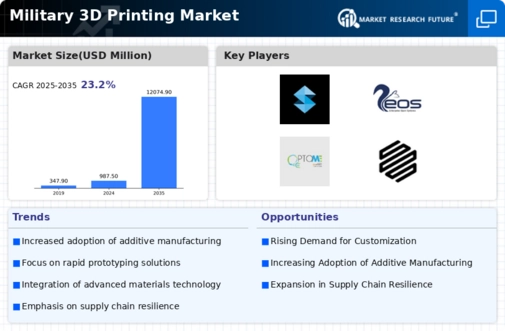Top Industry Leaders in the Military 3D Printing Market

The competitive landscape of the Military 3D Printing market is undergoing rapid transformation, fueled by the increasing adoption of additive manufacturing technologies across the defense sector. Key players in this market include established defense contractors, specialized 3D printing companies, and technology providers, all striving to leverage the benefits of 3D printing for military applications.
Strategies Adopted By Key Players Military 3D Printing Market
- Stratasys (U.S.)
- 3D Systems Corporation (U.S.)
- The Exone Company (U.S.)
- EOS GmbH (Germany)
- Arcam AB (Sweden)
- Norsk Titanium AS (U.S.)
- American Elements (U.S.)
- Cimetrix Solutions (Canada)
- Artec Europe (Luxembourg)
- 3T RPD (U.K.), Optomec Inc. (Mexico)
- Initial (France), Markforged (U.S.)
- Smg3D (U.K.)
- Engineering & Manufacturing Services (U.S.)
Key players in the Military 3D Printing market are adopting strategies centered around technological innovation, partnerships, and a focus on materials. Continuous investment in research and development is essential to enhance 3D printing technologies, improve material options, and address the specific requirements of military-grade components. Strategic collaborations with defense agencies, research institutions, and other industry stakeholders are common, facilitating knowledge exchange and accelerating the integration of 3D printing into military applications. Moreover, the development of high-performance materials compatible with military standards is a key aspect of the strategies adopted by leading companies.
Factors for Market Share Analysis: Market share analysis in the Military 3D Printing sector considers various factors, including the range of materials offered, printing technologies available, compliance with military standards, and the ability to produce complex, high-precision components. The versatility of 3D printing solutions in addressing different military needs, from rapid prototyping to on-demand production of spare parts, is a significant factor influencing market share. Additionally, the capability to provide solutions for both polymer and metal 3D printing, along with post-processing capabilities, contributes to the overall competitiveness of Military 3D Printing providers.
New and Emerging Companies: The Military 3D Printing market is witnessing the emergence of new and innovative companies focusing on specialized applications and materials. Start-ups such as Markforged and Aurora Labs are contributing to advancements in metal 3D printing for military-grade components. These companies often bring agility and a focus on specific military needs, such as lightweight and durable parts for aerospace and defense applications, challenging traditional players with novel solutions.
Industry News: Industry news in the Military 3D Printing market frequently highlights technological breakthroughs, successful applications, and collaborations. Recent developments, such as the use of 3D printing for critical components in military aircraft, advancements in high-temperature materials suitable for aerospace applications, and partnerships between 3D printing companies and defense agencies showcase the industry's commitment to innovation and addressing the unique challenges of military manufacturing. News related to successful field tests, certification processes, and case studies further shape industry perceptions and influence competitive dynamics.
Current Company Investment Trends: Investments in technology and innovation remain a key trend in the Military 3D Printing market. Key players allocate significant resources to research and development activities aimed at enhancing 3D printing technologies, expanding material options, and improving overall printing efficiency. Investments also focus on addressing specific military requirements, such as the development of materials with enhanced durability, strength, and resistance to extreme conditions. Strategic acquisitions and partnerships contribute to expanding product portfolios and addressing emerging market needs, reflecting the industry's commitment to staying at the forefront of technological advancements.
Overall Competitive Scenario: The overall competitive scenario in the Military 3D Printing market is characterized by a balance between established defense contractors and innovative newcomers. Established players leverage their experience, global presence, and diversified product offerings to maintain a competitive edge. Simultaneously, emerging companies contribute to the market's dynamism by introducing novel 3D printing technologies and materials, addressing specific challenges associated with military applications. The focus on providing end-to-end solutions, from design to production, further intensifies competition in this market.
Recent Development:
Lockheed Martin:
Successfully produced and deployed 3D-printed flight control system components for its F-35 fighter jet. This demonstrates the viability of 3D printing for critical aerospace applications.
BAE Systems:
Partnering with Norsk Titanium to develop advanced 3D-printed titanium components for military aircraft. This collaboration leverages Norsk Titanium's expertise in additive manufacturing with BAE Systems' aerospace platform knowledge.
Developing a portable 3D printing factory solution for rapid battlefield manufacturing of spare parts and tools. This would enhance operational flexibility and reduce reliance on traditional supply chains.










